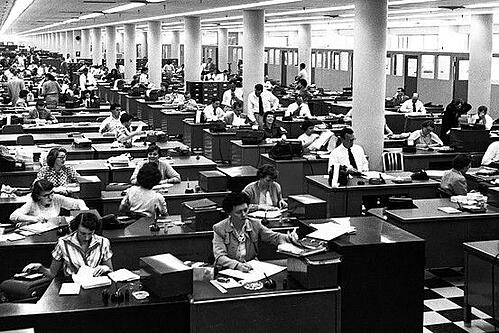Work from home is not a new concept. People have been looking for any excuse to do so since the turn of the century. Initially, Friday’s was the defacto work from home day. It’s popularity was driven mostly to get a jump on the weekend, more so than trying to get distraction free time in order to get caught up. For evidence, just check the highway traffic on Friday’s afternoons during the summer, as people are fleeing the city.
Over time as work from home became more and more accepted, Wednesday also became popular. Wednesday is a natural work from home day as it not only breaks up your week, but for many was a legitimate opportunity to work uninterrupted. The mid week isolation gave individuals the chance to focus on major assignments or priorities. Of course, people raved about how productive they are working from home and most were.
So what changed?
For centuries people have been making their way into the office. Initially most could walk to their place of employment. But over time, as cities grew, public transit became the norm for those who had to travel greater distance than walking. Finally, as the downtown core in many cities became the commercial hub and with people moving to the suburbs for affordable housing, the car began to dominate as the preferred method to commute in many cities.
As this cycle of commercial intensification in the downtown cores and suburb getting farther away, going to work went from a simple task to a stressed induced war pitting driver against driver to see who can gain the best lane advantage. Depending on where you lived, this daily ritual could easily last from 30 minutes to over an hour, twice daily. So needless to say, people started looking for any opportunity to get the occasional reprieve from this daily grind.
But that’s not all!
Another major catalyst for what has become the Work from Home (WFH) movement, is the growth of the open office concept. Long before Covid-19 changed our world, companies of all sizes were jumping on the open office concept. Gone were the cubicles, the open office concept, embraced by the major tech companies, was the model to follow.
Contrary to what is expounded by management of the team building benefits of an open office, the real motivation is cost saving. Open office concepts save a lot of money because they pretty much eliminate the need for all but minimal leasehold improvements. Plus they offer a ton of savings on office furnishings.
What I find genuinely interesting with the open office concept, is that most senior managers all end up with offices. If it’s good for the goose, shouldn’t it be good for the gander? Of course, they justify it based on their need for privacy. Shouldn’t these managers be subjected to the same restrictions and annoyances they place on their employees?
To be sure the open office concept is not new. Just check on those black and white photos of the clerical pools of 1950’s, where there were rows upon rows of desks in large rooms. But those were days before computers and automation. Most of those jobs were repetitive task driven activities and although these individuals were knowledgeable, they weren’t considered knowledge workers. Most of those tasks of yesteryear have been replaced by automated solutions with little human interaction.

So many of today’s workers are considered knowledge workers and are required to think and make decisions. They need to be creative and require time to focus. The reality is that as individuals, we are creative at different times of the day. Some individuals are at their best creatively in the morning, some at midday and other late afternoon and not necessarily everyday. Let’s be honest, creativity can very spontaneous and generally can’t be scheduled. So reserving one of the “quiet rooms” located on the perimeter of the open office concept, at a moments notice, is not always possible.
At the end of the day, the reason why people want to work from home is that there are too many distraction in the open office concept. Whether those distractions are in the form of visual, auditory, or human interruptions they abound everywhere and everyday. There’s just no privacy. Interruptions by fellow employees appears to be the most frustrating issue reported, because there’s no place to hide or call your own. An attitude that, you’re at your desk, therefore it’s okay to talk to you, is the norm. You’re living in a fishbowl.
As a result, individuals are going to great lengths now to develop the virtual version of “do not disturb” signals and it is stressing them out. Wearing headphones and not looking up when someone goes by, is essentially an indicator that “I’m busy”, but even then many teammates are oblivious to these indicators.
As a curious individual, I’m hard wired to be constantly scanning my environment. Maybe it’s a hold over from the prehistoric days when you really had to be aware of your surroundings, otherwise you became somebody’s lunch. So keeping my head down all day, is as big of a distraction as being interrupted.
Is work from home any better?
For people around the world, this wasn’t a conscious decision. Covid-19 just forced everybody’s hand to work from home because there wasn’t much of an alternative. After three months, many are liking it, but many aren’t and as time moves on, there appear to be cracks forming in their new love affair with the work from home concept.
For those fortunate to have a spare room, the transition was acceptable. However, if a couple are both relegated to work from home, then someone is going to get stuck at the kitchen or dining room table. This is okay for a day or two, but for three plus months, I don’t think so.
So, if this work from home movement is to become permanent, how are individuals going to manage this? You can’t expect most couples to share that spare bedroom and work side by side, that’s just a recipe for disaster. Most individuals can’t afford a bigger house, so what’s the option. What about condo and apartment dwellers? No, work from home is not sustainable under many individuals current lifestyle.
Taken a step further and assuming an individual has the physical space to work from home, who’s going to pay for all the necessary upgrades to make it workable and at what cost? What about security and liability? What if someone gets injured? What if someone trip or falls going to their home office, where does the liability begin or end? Is that a workers compensation issue or a safety issue? Believe me, I don’t have the answers and I’m not sure anybody does at this point.
Let’s talk about team unity
In order to maintain communication and team unity, everybody jumped on the available collaboration tools available such as Zoom, Microsoft Teams and albeit a little late to the party, Google’s Meet, just to name a few. For all the praise for the ease of use and quick implementation of these tools, it’s just not the same as an in person meeting.
Having participated in a few of these digital meetings, I’ve come up with some observations that I have no idea how they are to be solved. Granted people are getting far more comfortable on the platforms, but they are draining. Gone are all the physical queues we become accustomed to. When to speak, avoiding talking over someone paying attention are just a couple of the myriad of challenges individuals face on video platforms.
Because we’ve done it so long, most people are comfortable in live meetings, albeit bored on occasion. Being on a video conference requires 100% attention to the screen because you have 6, 10 or 20 people staring back at you for the duration, so you need to be on your best behaviour. Reports from individuals that are on video calls or meetings a good portion of their day, are reporting that they are exhausted, where they weren’t in in-person meetings.
Leaders checking in
Now I will profess that I subscribe to the Management by Walking Around style of management. I wasn’t aware that my style actually had a name until such time as I read In Search of Excellence by Tom Peters and Robert Wateman many years ago.
Essentially, it’s what the name infers. As opposed to a formal meeting, a manager wanders around checking in with their staff in an impromptu manner. It’s not about catching people slacking off, it’s about creating informal teaching moments. But at a deeper level, it’s about connecting with your staff by having more face time. The concept apparently originated at Hewlett Packer or HP as it is known today.
There was a study done by Leadership IQ on the Importance of Leadership. The report states that 50% of employees spend less than 3 hours a week with their leader. However, those that spend 6 or more hours per week with their leaders are
- 29% more inspired
- 30% more engaged
- 15% more motivated
- 10% more innovative
This level of engagement, although possible, will be difficult to achieve using video conferencing. Managers of all types will need to reinvent themselves if work from home is the new normal. I’m just not sure it’ll be as effective as face-to-face.
If this is ever going to work, managers will need to up their game and reinvent themselves. Team members will worry that because they are out of site, they’re out of mind and fear they won’t get the recognition they want or more importantly need.
Personal boundaries
The curse of the smartphone has stretched many peoples day, as emails or text messages come in at all hours of the day. As a result, many have defaulted into responding to them no matter when they come in. The justification is that it’s only one email and, what the heck, if I answer it now, it’ll be one less thing to do tomorrow. In addition, email and messaging has created a false sense of urgency and therefore an answer is expected immediately. This was bad enough before Covid-19 and I can only imagine what the new normal will look like.
Where all this really falls apart is if people are permanently anchored at home, they naturally loose their work boundaries. They’ll take advantage of doing errands that were traditionally relegated to nights and weekends. And they’ll justify it by they can catch up on their work later that night or weekends. Boundaries are going to get blurred by managers and employees alike.
Humans are social
Let’s remember, that for the most part humans are social and need interaction. That can’t be replicated on video or conference calls. There’s a potential risk that people will start to feel disconnected from the rest of your team as all those informal interaction become a thing of the past.
What companies need to be on the lookout for will be the potential reduction in innovation and creativity, much of which just happens when colleagues pump into each other at the water cooler or in the hallway. This can’t be replicated digitally.
Work from home has been tried in the past by some very large corporations and their experiments failed miserably. Granted the advance in technology will certainly improve the odds, but I don’t believe by much. IBM for all it’s technological know how, recalled about 11,000 of their employees back into the office 18 months ago after realizing they were missing out on the innovation that just happened through interacting in person.
What’s the solution?
When Covid-19 is in our rear view mirrors, I think most people will be back in their workplaces and rumours of the death of the office are premature. What might be interesting is a hybrid solution, whereby people will able to split their week or rotate days that they’re in the office. But for those companies, that are going fully remote, you’ll need to create some very unique skills in order to keep your teams organized, motivated and loyal. It won’t be easy
Get More LIFE Out of Your Business
You shouldn’t be the hardest working person in your company.
Many small business owners find that even after the struggling start-up years, they’re working too many hours and still managing every aspect of their businesses.
Greg Weatherdon has been there, done that. As an entrepreneur, he learned not only how to get a business to the point of running smoothly, but also how to reduce the number of hours he worked, delegate more responsibility to his employees, and take longer vacations while his business chugged along like a well-oiled machine. And now he is providing the secret to success.
Do you suffer from any of the following?
1. Business ownership isn’t living up to the dream.
2. Endless workdays.
3. You can’t find good people.
4. Profits are less than expected.
5. You can never take a vacation.
You’re not alone. But there is a solution. As Greg demonstrates, with some time and effort, you really can Get More Life Out Of Your Business.



